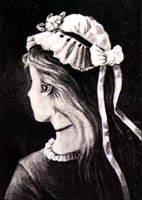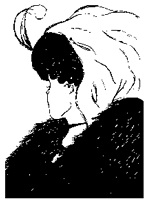In the reactions to the previous post, I realize that I created a false impression that I want to rectify. It seems that my language caused people to zoom into a sort of Hitlerian framework of understanding Obama. Much as we should distrust this man, this was not the impression I meant to convey. Neither is it necessary for a "Hitler" to arise as the leader of the U.S., in order for Israel, and by extension Jews everywhere, to be in very deep trouble indeed.
For Israel to be in trouble, all that is required is that the U.S. shift in its basis of security, moving away from classic approaches, towards those more common in Europe and the third world.
The classic basis of American security is American "exceptionalism", the notion that the U.S. is singularly blessed by God, among all nations on Earth, because of its unique form of government. The essence of this notion can be reduced to this -
a justice logically based upon the chochma of the G of the universe is superior to any merely human form of government. It is this exceptionalism that is at the core of identification with Jews and Israel. It is also this exceptionalism that has allowed a unilateralism that shielded us from world opinion. US Public opinion could be summarized something like this. "What matter if Europeans and Arabs don't like our economic system or foreign policy supporting Israel? They are a rather unimpressive, cowardly lot that depend upon us anyway". This view, while widely shared, is most prevalent in the Conservative community.
What we need to understand, is that our long involvement in inconclusive wars, topped off by an unprecedented failure of our economic system, has opened the door to systemic change regarding exceptionalism itself. It is not accidental that Mccain was making headway laughing at Obama's flowery, meaningless rhetoric a few short months ago, while today- no one is laughing. Talking in terms of reinterpreting
ikrim sounds laughable in normal times, but as a "change" that could "restore hope" in times of deep crisis. This was what allowed the "new deal" a generation ago, the "patriot act" after 9/11 and what will allow a virtual nationalizing of our economy now. The essential point here is-
exceptionlism is dead, security through fitting in with the world is in.
It is not necessary for a U.S. government to transform into an Arab society for disaster to occur to Israel. Was it necessary for America to become Hitlerian for millions to die at the hands of Germany or Vietnam?
All that was needed was an excuse to remove the support that had held the genocidal forces from acting before.
The Europeans and third world are united in their inability to understand the basis of American exceptionalism. Europeans are far to materialistic to understand the American idea of natural justice. Europeans don't believe in God- they don't believe in one nation under God, but rather in one nation under Man. This belief in Man causes hatred for American's as believers in God, as well as a deep hatred for Jews.
As one might expect, if we explore the European democracies, we will see, not Hitlerian anti Semitism, but very real Jew hatred nonetheless. While there is obviously some guilt at this hypocrisy of hating a fellow Man, Jew hatred redeems itself through the excuse of the image of "injustice" to the native Palestinian by the colonial Jew. But this is not the real issue. The article showing Europeans viewing Israel as the #1 threat to world peace attests to that. The #1 danger to world peace? The #1 Czechoslovakia opportunity to appease Arabs and third world tyrants would be more like it. If we explore Arab society, we get much closer to Hitlerian hatred and imagery, as we have all seen innumerable times on T.V. and the U.N. The Muslim hatred comes from a competing notion of God, rather than the absence of one.
The European, Arab / third world partnership is Genocidal to Israel. Their concept of "justice" allows for nothing less than the dismantling of "colonial" Israel and the liberation of the "victimized" Palestinian. While the passionate Arab does the killing in the name of his God, the European watches eagerly on B.B.C. enjoying the murder of Jews while he self righteously "tut tuts" at the foolish Jew who brought this on himself through his own greed and injustice to Man. The only natural force that holds this back, is massive American force of aid and military, diplomatic support.
This religious, exceptionalist "unilateral" approach that identification with Jews and Israel depends upon, is not consistent with the secular, consensus approach with Europe and the third world that democrats and Obama advocate. Any move therefore toward such consensus, is a revolutionary change in America and a danger to Israel and Jews.
If we take into account the extreme financial crisis we are in, as well as the fact that Iran is about to go Nuclear, the danger to Israel becomes mortal. A Mccain exceptionalist would have viewed it as the right, honorable and necessary thing to use military force to prevent Iran as an enemy of Democracy from acquiring nuclear weapons. If need be, this would have been done unilaterally.
An Obama will be far too equivocal to act decisively. His complex conflict about "liberation theology" will not allow for a unilateral action. Such action would imply a real break with tribalism, something Obama cannot do as we saw with Wright.
We must remember, an important part of Obama, the part that happily listened to Wright in church for all these years, sympathizes with hatred of America and wants "victims" like Iran to have nuclear weapons. This equivocation will mask itself as "diplomacy", "soft power" multilateralism or the like. What it really
is, is a break with the notion of natural justice and American exceptionalism that promotes identification with Jews. In its stead comes a sympathy with Muslims as fellow tribal "victims".
Without defeating Iran, we are going to have to be make a deal the Arabs. The oil rich states will have to be propped up, and that propping up will demand tangible progress on the Israel front. Nothing less than tangible progress on the Israel front will allow the Oil states to remain in the Western alliance.
Tangible progress means indefensible borders for Israel, especially as aid and weapons begin to wane from an America equivocating about itself and Israel.


